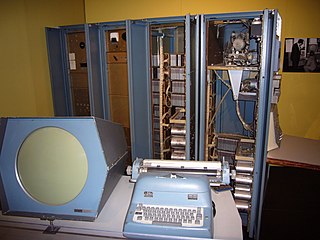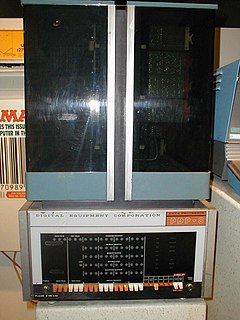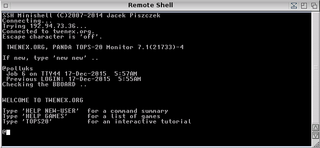Related Research Articles

ASCII, abbreviated from American Standard Code for Information Interchange, is a character encoding standard for electronic communication. ASCII codes represent text in computers, telecommunications equipment, and other devices. Most modern character-encoding schemes are based on ASCII, although they support many additional characters.
The byte is a unit of digital information that most commonly consists of eight bits. Historically, the byte was the number of bits used to encode a single character of text in a computer and for this reason it is the smallest addressable unit of memory in many computer architectures.

In computing and electronic systems, binary-coded decimal (BCD) is a class of binary encodings of decimal numbers where each digit is represented by a fixed number of bits, usually four or eight. Sometimes, special bit patterns are used for a sign or other indications.
Digital Equipment Corporation, using the trademark Digital, was a major American company in the computer industry from the 1960s to the 1990s. The company was co-founded by Ken Olsen and Harlan Anderson in 1957. Olsen was president until forced to resign in 1992, after the company had gone into precipitous decline.

The octal numeral system, or oct for short, is the base-8 number system, and uses the digits 0 to 7. Octal numerals can be made from binary numerals by grouping consecutive binary digits into groups of three. For example, the binary representation for decimal 74 is 1001010. Two zeroes can be added at the left: (00)1 001 010, corresponding the octal digits 1 1 2, yielding the octal representation 112.

Digital Equipment Corporation (DEC)'s PDP-10, later marketed as the DECsystem-10, is a mainframe computer family manufactured beginning in 1966 and discontinued in 1983. 1970s models and beyond were marketed under the DECsystem-10 name, especially as the TOPS-10 operating system became widely used.

The DECSYSTEM-20 was a 36-bit Digital Equipment Corporation PDP-10 mainframe computer running the TOPS-20 operating system.

Programmed Data Processor (PDP), referred to by some customers, media and authors as "Programmable Data Processor, is a term used by the Digital Equipment Corporation from 1957 to 1990 for several lines of minicomputers. The name "PDP" intentionally avoids the use of the term "computer" because, at the time of the first PDPs, computers had a reputation of being large, complicated, and expensive machines, and the venture capitalists behind Digital would not support Digital's attempting to build a "computer"; the word "minicomputer" had not yet been coined. So instead, Digital used their existing line of logic modules to build a Programmed Data Processor and aimed it at a market that could not afford the larger computers.

The PDP-8 is a 12-bit minicomputer that was produced by Digital Equipment Corporation (DEC). It was the first commercially successful minicomputer, with over 50,000 units being sold over the model's lifetime. Its basic design follows the pioneering LINC but has a smaller instruction set, which is an expanded version of the PDP-5 instruction set. Similar machines from DEC are the PDP-12 which is a modernized version of the PDP-8 and LINC concepts, and the PDP-14 industrial controller system.

UTF-8 is a variable-width character encoding capable of encoding all 1,112,064 valid character code points in Unicode using one to four one-byte (8-bit) code units. The encoding is defined by the Unicode Standard, and was originally designed by Ken Thompson and Rob Pike. The name is derived from UnicodeTransformation Format – 8-bit.

The TOPS-20 operating system by Digital Equipment Corporation (DEC) was a proprietary OS used on some of DEC's 36-bit mainframe computers. The Hardware Reference Manual was described as for "DECsystem-10/DECSYSTEM-20 Processor".
RT-11 is a discontinued small, single-user real-time operating system for the Digital Equipment Corporation PDP-11 family of 16-bit computers. RT-11 was first implemented in 1970 and was widely used for real-time systems, process control, and data acquisition across the full line of PDP-11 computers.

The PDP-6 is a computer model developed by Digital Equipment Corporation (DEC) in 1964. It was influential primarily as the prototype (effectively) for the later PDP-10; the instruction sets of the two machines are almost identical.

In computer architecture, 36-bit integers, memory addresses, or other data units are those that are 36 bits wide. Also, 36-bit CPU and ALU architectures are those that are based on registers, address buses, or data buses of that size. 36-bit computers were popular in the early mainframe computer era from the 1950s through the early 1970s.
The Massbus is a high-performance computer input/output bus designed in the 1970s by Digital Equipment Corporation (DEC).
Densely packed decimal (DPD) is an efficient method for binary encoding decimal digits.
A six-bit character code is a character encoding designed for use on computers with word lengths a multiple of 6. Six bits can only encode 64 distinct characters, so these codes generally include only the upper-case letters, the numerals, some punctuation characters, and sometimes control characters. Such codes with additional parity bit were a natural way of storing data on 7-track magnetic tape.
In computer architecture, 18-bit integers, memory addresses, or other data units are those that are 18 bits wide. Also, 18-bit CPU and ALU architectures are those that are based on registers, address buses, or data buses of that size.
SQUOZE is a memory-efficient representation of a combined source and relocatable object program file with a symbol table on punched cards which was introduced in 1958 with the SCAT assembler on the SHARE Operating System (SOS) for the IBM 709. A program in this format was called a SQUOZE deck. It was also used on later machines including the IBM 7090 and 7094.
TENEX was an operating system developed in 1969 by BBN for the PDP-10, which later formed the basis for Digital Equipment Corporation's TOPS-20 operating system.
References
- 1 2 Jones, Douglas W. (2018). "Lecture 7, Object Codes, Loaders and Linkers - Final steps on the road to machine code". Operating Systems, Spring 2018. Part of the CS:3620 Operating Systems Collection. The University of Iowa, Department of Computer Science. Archived from the original on 2020-06-06. Retrieved 2020-06-06.
- ↑ Durda IV., Frank (2004). "RADIX50 Character Code Reference". Archived from the original on 2005-03-31. Retrieved 2005-03-31.
- ↑ "Appendix 1". PDP-9 Utility Programs--Advanced Software System--Programmer's Reference Manual (PDF). Maynard, Massachusetts, USA: Digital Equipment Corporation. 1968. Order No. DEC-9A-GUAB-D. Archived (PDF) from the original on 2020-06-04. Retrieved 2020-06-04.
- 1 2 3 4 "8.10 .RAD50". PAL-11R Assemler - Programmer's Manual - Program Assembly Language and Relocatable Assembler for the Disk Operating System (2nd revised printing ed.). Maynard, Massachusetts, USA: Digital Equipment Corporation. May 1971 [February 1971]. p. 8-8. DEC-11-ASDB-D. Retrieved 2020-06-18.
[…] PDP-11 systems programs often handle symbols in a specially coded form called RADIX 50 (this form is sometimes referred to as MOD40). This form allows 3 characters to be packed into 16 bits; therefore, any 6-character symbol can be held in two words. The single operand is of the form /CCC/ where the slash (the delimiter) can be any printable character except for = and : . The delimiters enclose the characters to be converted which may be A through Z, 0 through 9, dollar ($), dot (.) and space ( ). If there are fewer than 3 characters they are considered to be left justified and trailing spaces are assumed. […] The packing algorithm is as follows: […] A. Each character is translated into its RADIX 50 equivalent as indicated in the following table: Character - RADIX 50 Equivalent (octal): (space) - 0, A–Z - 1–32, $ - 33, . - 34, 0–9 - 36–47. Note that another character could be defined for code 35. […] B. The RADIX 50 equivalents for characters 1 through 3 (C1,C2,C3) are combined as follows: RESULT=((C1*50)+C2)*50+C3 […]
- ↑ PDP-11 Getting DOS on the Air (1 ed.). Maynard, Massachusetts, USA: Digital Equipment Corporation. August 1971. DEC-11-SYDC-D. Retrieved 2020-06-18.
- ↑ "Appendix B.3: Radix-50 Constants and Character Set". Compaq Fortran 77 Language Reference Manual. Compaq Computer Corporation. 1999. Archived from the original on 2012-10-14. Retrieved 2012-10-14.